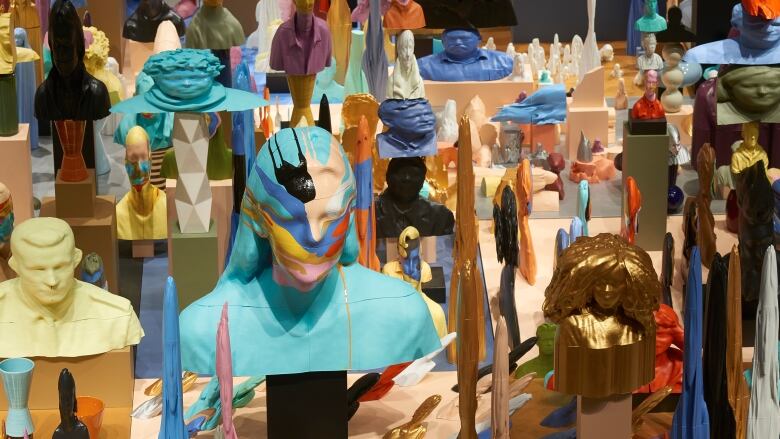The selfie killer: Douglas Coupland says 3D printing will transform the art world
'You scan it and — poof! — you get home and you print it out'

Canadian artist Douglas Coupland spent the last three years scanning and 3D printing the heads of everyday Canadians.
His latest artwork, The National Portrait on display at the Ottawa Art Gallery until Aug. 19, is made up of 1,000 of those multicoloured busts — built from 71 kilometres of plastic filament — in varying states of disfigurement.
Coupland likens it to the Terracotta Army discovered in China during the 1970s — a representation of Canada to one day be uncovered.
"If you were to dig this up ... you go, 'Oh! Well, who are these people?'" Coupland told Day 6 guest host Nana aba Duncan.
"I think this project really is a really lovely time capsule."

Measuring seven metres by seven metres in total, with some heads nearly a metre tall, Coupland gathered the busts by travelling across Canada.
Hundreds waited in line at each location to have their miniature sculpture created. "19 out of 20," Coupland guessed, had never encountered a 3D printer and were simply curious.
But there was another group who ended up surprising Coupland.
"Every city, there would be one or two — I'll call them dads — and they were being dragged there by their … children. And they're like, 'What are we doing this for?'" Coupland recalled.
As the scanner developed their 3D portrait on screen, very quickly the "dads" answered their own question.
"Suddenly they can see the back of their head and they go, 'Oh my god! ... This is amazing! We're getting a 3D printer for Christmas!'" Coupland said.

Yet one encounter stands out for the artist.
"It's actually this one older woman — maybe in her late sixties. She was at an event in Mississauga [Ont.], very nicely dressed, by herself and didn't didn't say much."
"As she was leaving she said, 'I want to be part of the future.'"
3D printers could change sculpture
Coupland began 3D printing about four years ago. It started when he was quoted $4,000 to build a scale model for an art piece.
In the same way that photography changed painting in the early 19th century — it "freed" painters to be impressionistic — 3D printing might soon change sculpture, Coupland said.

He said it is a "surprisingly democratic" technology and could eventually provide a tangible alternative to the tried-and-true selfie.
"It's a very, very untapped art medium. The young people are really embracing it and doing quite remarkable things with it."
Coupland believes anyone with a cellphone will have the ability to create sculptures at home using a 3D printer.
"You can be at a party or whatever just like, 'I'm going to circle you, or I'm going to circle this piece of furniture,'" he said. "You scan it and — poof! — you get home and you print it out."
'Big, stretchy piece of Silly Putty'
While Coupland is a multidisciplinary artist, sculpture has a profound effect on him.
"I've always preferred the third over the second dimension," he said. "The thing about 3D printing is it's an object and becomes an object in your space and you have to learn to live with that."

As visitors take in The National Portrait, they're forced to circle around it and see it from all angles. The busts are not only diverse in who they represent, but how they're shaped.
Some are long and tall like an upright icicle. Others are cartoonishly flattened as if an anvil fell on them.
"Head on they look like a big, stretchy piece of Silly Putty, and from the side, they make a perfect profile or cameo," Coupland said.
"It really forces your brain to go into that third dimension in a way that maybe it doesn't get so much anymore."
To hear more from Douglas Coupland, download our podcast or click Listen above.